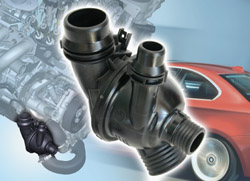plasticker-News
| 2008-07-04 |

|
DuPont: Housing of DuPont™ Zytel® HTN for map-controlled thermostat withstands complex stresses
|
The housing of the map-controlled thermostat by Behr Thermot-tronik (Kornwestheim, Germany, www.behrthermottronik.de) which is installed in BMW’s N43 series four-cylinder petrol motors, is exposed to a combination of very high mechanical, thermal and chemical stresses. To enable this complex part to withstand the application’s demanding requirements dependably over long periods, Behr decided to make the housing out of DuPont™ Zytel® HTN high-performance polyamide (www.dupont.com). “As the thermostat is right next to the cylinder block, it works in an ambient temperature anywhere between –40 °C to +150 °C,” says Barbu Frunzetti, project leader at Behr Thermot-tronik. “In addition, the exterior surface is exposed to typical motor-compartment media, such as oils, greases, fuel and road salts. Inside the thermostat housing, coolant flows at up to 140 °C. The return spring’s pretensioning force against the wall of the housing comes on top of the interior pressure of up to 2,5 bar. Moreover, when in operation the whole system is constantly under vibrational stress. Taken together, these parameters exceed the capabilities of conventional polyamides used in under-the-bonnet applications.” Processing requirements further limit the range of plastics which could be used for this part. The housing’s injection-moulded halves have to be welded together in a cost-efficient and reliable manner. The resultant seams must have the strength to withstand burst pressures many times higher than the nominal pressure. In addition, the material must allow other complete plastic parts—connector plugs overmoulded in nylon 66 for the electronic control system—to be hermetically overmoulded. “In extensive comparative tests with other thermoplastics, DuPont™ Zytel® HTN 51G35HSLR high-performance polyamide met our demanding requirements best,” Frunzetti continues. “This polyphthalamide (PPA) reinforced with 35 % glass fibre has the required high static and dynamic strength, the dimensional stability over a broad temperature range essential for this application, high chemical and hydrolysis resistance, good flowability and high compatibility with PA 66. It is also very well vibration-weldable.” Behr Thermot-tronik worked closely with DuPont to choose and optimise the welding process. “This housing for the map-controlled thermostat for the BMW N43-series motor is, as far as we know, the first component of its kind to be vibration-welded,” comments Andreas Oldeweme, who works in Automotive Market Development at DuPont. “Accordingly, the preparatory work was very thorough before this process was integrated into volume production. First of all, in comprehensive tests carried out in DuPont’s European Technical Centre in Geneva we compared various welding processes, including laser welding. It finally turned out that friction-welding offered definite application-related advantages. Working together with the welding equipment manufacturer, Behr Thermot-tronik then converted our test-specimen results into practice with the real thermostat housing and thus ensured rapid and reliable production of the part.” To simplify installation, Behr Thermot-tronik’s map-controlled thermostat is executed as a module in an integral construction method. Apart from the thermostat itself, it includes the connecting leads to the cooling system and the electric contact between the map-control system and the heating resistance. This ensures optimum coolant flow as well as a dependable electricity supply for the heating resistance. Yet it takes up hardly more space than conventional integral thermostats. “As a result of DuPont’s extensive application-related support and the good results we have had to date with the processing, Behr Thermot-tronik is now using Zytel® HTN for further map-controlled thermostats of which some are in development and others already in production,” says Frunzetti. Background Information on Electronic Map-Controlled Thermostats In conventional cooling systems a wax element keeps the coolant temperature close to about 90 °C. This control method ensures that the motor does not overheat even under extreme conditions, such as very high vehicle speeds, very high ambient temperatures and heavy loads. However, in normal conditions a petrol engine can generally be operated at 110 °C without danger. This high temperature improves tribological conditions in the motor, which in turn reduce friction losses, fuel consumption and exhaust emissions. An electronic map-controlled thermostat can satisfy such variable requirements, because it can adapt the coolant temperature to the motor’s operating conditions within broader limits. With the motor at partial load it maintains the coolant temperature at a consistently high level; at full load, high engine speeds or high outside temperatures it reduces the temperature and thus ensures performance characteristics which match these conditions. |
DuPont de Nemours (Deutschland) GmbH, Bad Homburg v.d.H., Germany
 back to news list back to news list |  back to top back to top |












